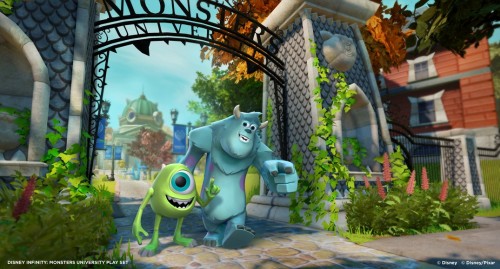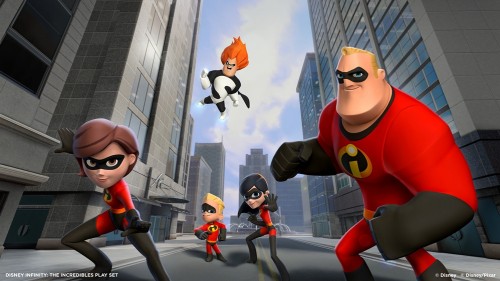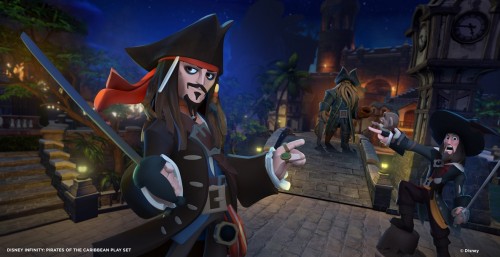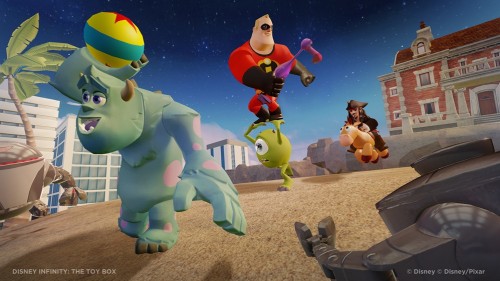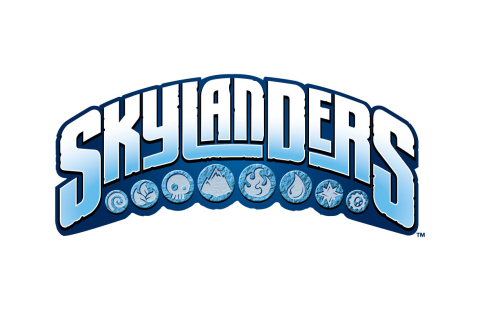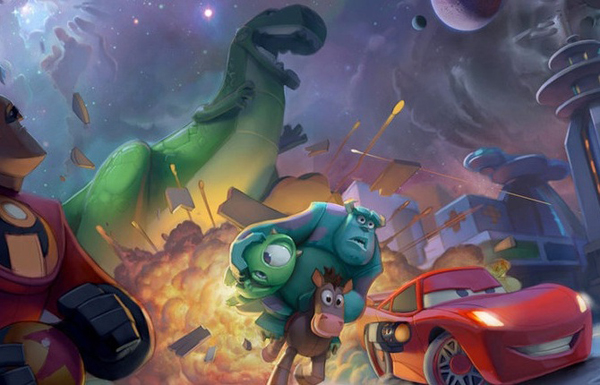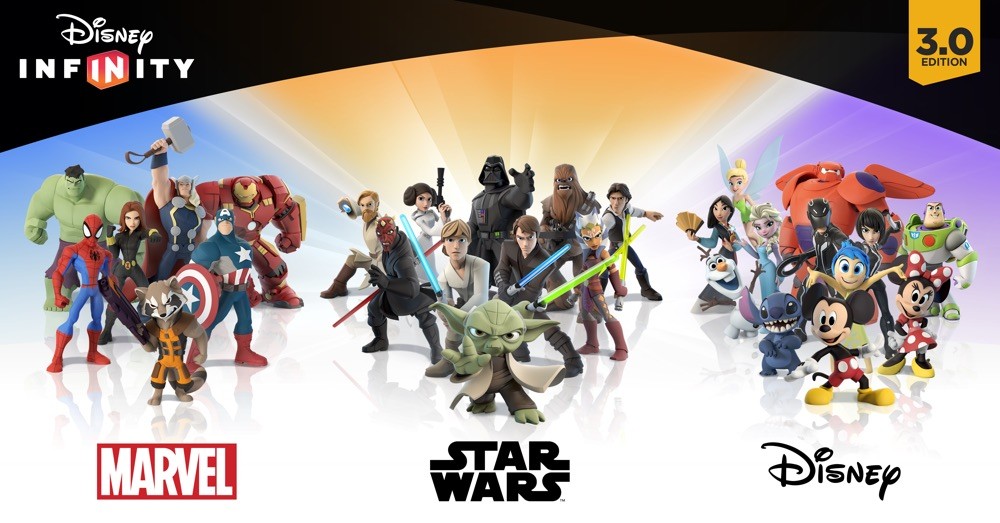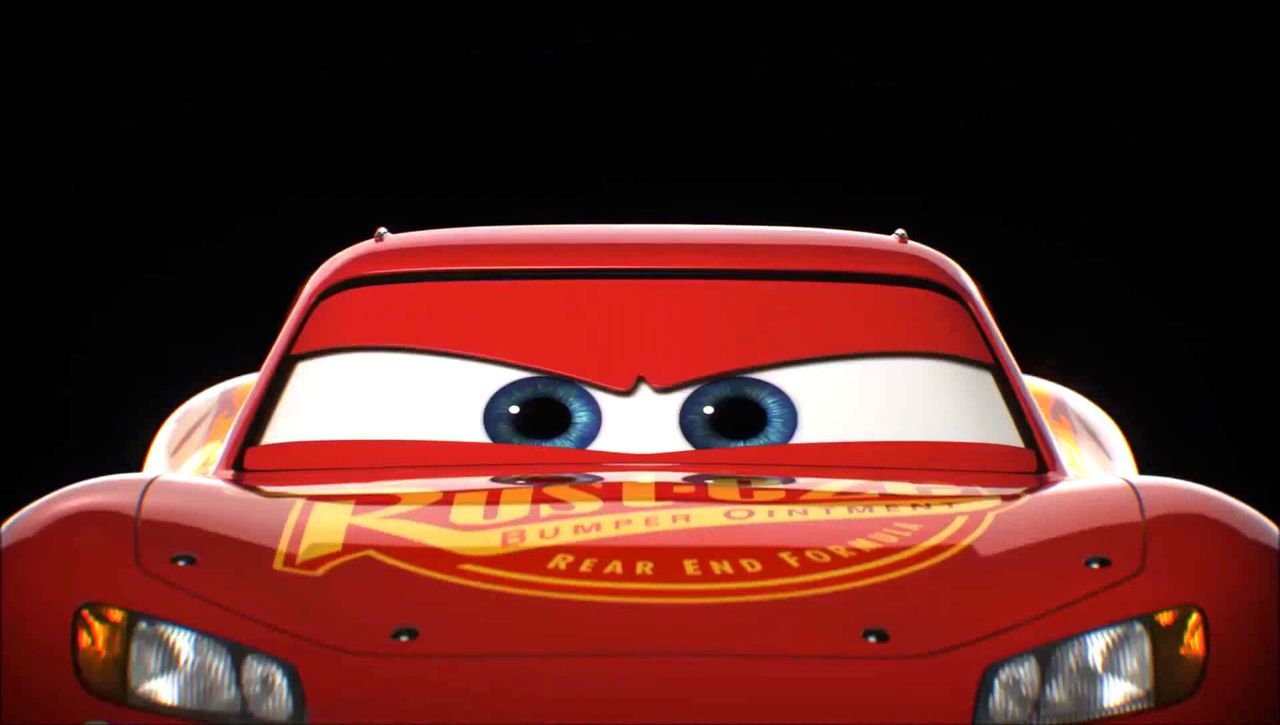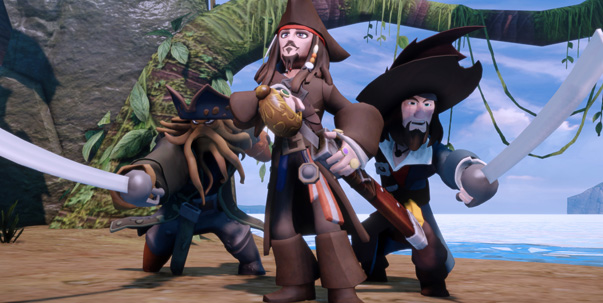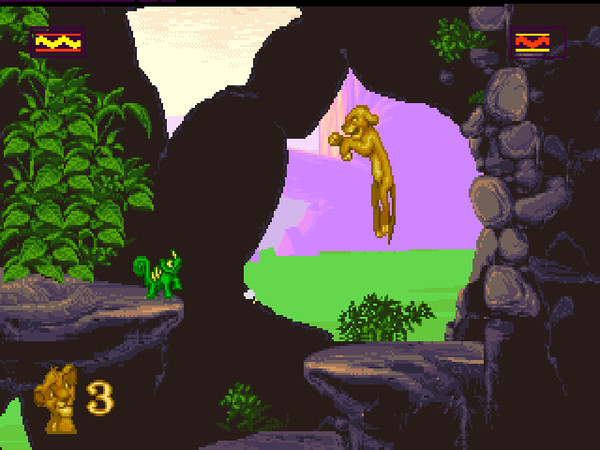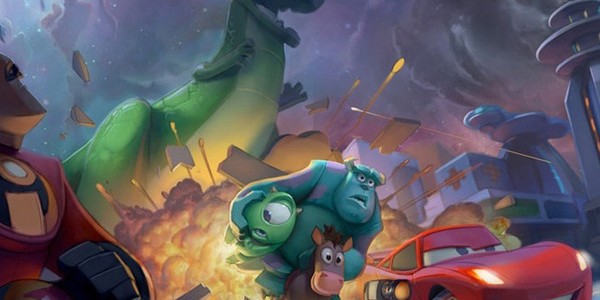
I doubt I was alone in conjuring thoughts of Scrooge McDuck diving into his vault of wealth when word leaked of Disney’s venture into Skylanders territory. Activision were right to bank on their figurine collecting virtual paradise bringing both success and wealth, and the notion that Disney would pursue similar goals with their infinitely more global properties no doubt had shareholders gleefully catatonic. But for those of us at home absent of shares and long term company investments, all we knew of (as it was called) Disney Infinity was that it was a little bit Minecraft, a little bit Skylanders, and maybe even a little bit Grand Theft Auto. That’s the sandbox part, not the whole “beat a sex worker to death with a meat cleaver” thing.
But as it tends to be with all these things, no leak or rumour was to have the corporate giant buckle and spill the beans. Disney were to play their cards how they see fit, and when they see fit. We waited and waited to hear more, and finally that when is now. Much to my delight, I had the chance to sit down and watch a press briefing dedicated to all the ins and outs of Disney Infinity. And though it’s easy to critique a company like this for obvious product marketability, let me put this on the table right now: Disney Infinity is one hell of an ambitious project, and for many Disney fans could be the game they’ve been knowingly or unknowingly waiting for.
Getting it out of the way, yes Disney Infinity draws parallels with Skylanders, combining the interactive scope of software with real, physical objects purchased and collected to expand the former. According to John Blackburn, CEO of Disney subsidiary Avalanche Software, Disney Infinity was born from watching the way children play with toys. The way children have always played with toys. They sit together, muck about, and craft these elaborate scenarios and worlds for their characters to interact in. Stick the hand in the toybox, pull out a new character, and the story takes a turn to adapt to the change. It doesn’t matter who the character is or their relevance to the running plot, the kids will adapt as they explore their creativity.
Disney Infinity is kinda like that. Drawing from the roots of Avalanche’s Toy Story 3: The Game, which featured a surprisingly addictive sandbox mode, Disney Infinity is all about exploring creative and free play. At first, Disney Infinity was to be a Buzz Lightyear themed sequel to Toy Story 3: The Game, but after convincing chief creative officer of Pixar and Disney, John Lasseter, that the experience would be far more enjoyable with more “toys” to play with, the decision was made to expand the concept into a multi-IP behemoth.
So yes, numerous Disney properties will make an appearance in the game, and most of these properties will be unlocked and acquired by purchasing Skylanders-esque figurines, them and the game worlds stylised under a new Pixar-like cohesive art direction. An umbrella style of sorts to better link the numerous properties together, gifting cohesion between otherwise strikingly different art styles of Disney’s many worlds, to ensure we’re not stuck with a horrifically realistic, uncanny valley Jack Sparrow fighting alongside CGI Monsters Inc. Sully. It’s all very clean and Pixar-like.
Exploring the adventure that is Disney Infinity splits players between two game modes: Play Set and Toy Box. Both are fairly self explanatory. Play Set focuses on a specific Disney property, including characters, locations, and objects, meanwhile Toy Box is a hyperactive mismatch of…everything.
Play Sets are unlocked by purchasing Play Set figurines, and once unlocked will allow players to explore property themed game worlds littered with characters, tools, and missions. Avalanche’s objective is to give each Play Set world a distinct gameplay theme beyond the aesthetic, as well as drive creative and experimental play. To show just how this concept works, Avalanche demo’d the three core Play Set kits that will be available when Disney Infinity launches a little later this year: Pirates of the Caribbean, Monsters University, and The Incredibles.
For example, The Incredibles is themed after an alternate ending to the film, taking place in a city under Syndrome’s reign of terror. Playing as any one of the memorable The Incredibles cast, this Play Set aims to embody players with the sensation of being a superhero. That means Mr Incredible can punch his way out of anything, Mrs Incredible can stretch her way across rooftops, Dash can…Dash, and Violet channels her energy shield. The iconic imagery of their superpowers are available for play right off the bat, with the Play Set seemingly focusing on brawler-like battles not unlike what you’d see in a comic book.
Meanwhile something like Monsters University is completely different. You won’t be punching through walls and stretching across buildings here, but instead wound up in a rivalry with a nearby fraternity, aiming to outwit and outprank one another. In this sandbox environment characters like Sully and Mike are tasked with building prank traps catch the opposition, as well as make a mess of the game world with tools like the toilet paper gun. With control over day/night cycles, Monsters University also makes use of a stealth and scare system, allowing players to switch to night and sneak around the campus scaring victims.
Lastly, Pirates of the Caribbean takes players across set pieces covering the first three films. As you can probably imagine, sword dual are a common feature of this Play Set, but the real focus is on exploring the sea. Players are gifted their very own pirate ship, and given the ability to freely sail the game world, sailing from island to island in search of treasure, with the occasional ship dual in between.
As each Play Set is firmly grounded in their own universe you won’t see Sully invading Captain Jack’s shores, but this is a very deliberate decision in order to keep the Play Set experiences focused and objective driven. These environments are populated by NPCs that will task players on quests to collect goodies, defeat bad dudes, and solve puzzles, often rewarding with new equipment and toys to play with. This is where the whole Grand Theft Auto sandbox element comes into play. Rather that stick with just the characters, Disney Infinity also wants to deck said characters out with mounts and weapons/equipment that give them special abilities and new ways to interact with the game world. Sully can ride a bike and shoot a toilet paper gun. Jack will arm himself with a flintlock and grenades along with his sword. The Incredibles can jump behind the sticks of a helicopter. And so on.
Avalanche also stressed the importance of construction. Outside of the Toy Box, they want every Play Set to also contain some kind of customisable home base, a rock in each player’s world, to help them personalise the experience. The Incredibles have their spy tower. Sully and co have their dorm. And Captain Jack has his pirate ship. Unlocking paints and parts allow each one of these locals to be tailored to suit the player’s style and taste, as well as unlock new experiences to interact with the game world. Your home base isn’t just a pretty picture, it’s a part of the game world. Unlock boxing bags on The Incredibles’ tower and you can punch those bags. Tailor Jack’s pirate ship with cannons that each have a different firing style, as well as the entire crew. It’s a seamless, interactivity driven experience.
And because Avalanche does not want you to play alone, each of these Play Sets boasts co-operative play. For example, during Pirates of the Caribbean, two players could man a single ship, one steering while the other runs across the deck manning the cannons. Or both players could take their own ships to the sea for duals against each other and enemies. Every playset is co-operative to some degree.
That’s Play Sets. Toy Box is like if you stripped Play Sets of all sense of grounding and focus and went totally crazy. It is exactly as it sound: a gigantic sandbox environment composed of all the big and little things you’ve acquired through Play Sets, now mashed together into one big fun filled extravaganza. Here is where you can play as Sully wearing Buzz Lightyear’s jetpack while riding Abu the elephant from Aladdin. Or Jack Skellington from The Nightmare Before Christmas drifting around the city from The Incredibles in Cinderella-esque carriage. This is where the idea of kids sitting around playing with toys, imagining their own worlds and adventures, really comes to fruition.
Limitless play and creativity is the focus of sandbox. Yes, you can play as any of your unlocked characters. Yes, you can use all the toys and equipment you’ve discovered, mix-matching them with any character you please. But the very fabric of the game world is also open to your imagination. Enter Minecraft, or maybe even a little The Sims. Using the construction tool kit players can reshape the entire game world however they see fit. Bridges, buildings, blocks, terrain, roads, tracks, hills, oceans: you name it, it’s there. And for the smarter kids (and adults, who we know will lap this up), the creation tools also include many LittleBigPlanet like triggers, platforms, and enemy spawns that have potential to lead to more inventive and involved play. This comes right down to the camera perspective. Avalanche showed two examples, one where the camera perspective changed to a side scroller, allowing for more traditional 2D-style platforming, while the other took an overhead isometric view, resembling a top down twin-stick shooter. In another example, showcasing the what’s possible with the toolkit, a player had recreated Bowser’s Castle from Mario Kart Wii, and then proceeded to race around it with their own Disney-themed car and characters. Did I mention much of the game world is physics driven? Allowing you to build a gigantic tower, then knock it down in real time? Yeah, you can do that. And to top it off, Toy Box themes the aesthetics of your creations based on the character you happen to be playing with at the time. Jack Skellington’s racetrack and game world will look differently to Sully’s. It’s in the details.
Though not objective driven, Toy Box mode is flavoured by “adventures”, each guiding the player through the tools and features of Toy Box through small story driven missions. Basic adventures might be a simple as helping a little pirate character cross a chasm and enter a treasure cave, teaching you how to place blocks to bridge the chasm, as well as create the cave. Mastery adventures on the other hand deal with more complex features, like the triggers, to create more elaborate structures.
As expected from any game in the modern age, Disney Infinity is multiplayer ready. I know I mentioned co-op for the Play Sets, but the Toy Box is enhanced too, with four player drop in/out online multiplayer. You can create worlds for friends to jump in and experience, and vice versa, bringing your characters together for all sorts of totally insane adventures. Disney is also promoting content sharing features, allowing users to upload their game worlds to Disney servers to be moderated, and then (if they’re approved) have their worlds circulated to other gamers. Disney also intends to host construction themed competitions, rewarding players who are most creative.
On a purely interactive level, the scope of Disney Infinity is difficult to fathom, at least in terms of realistic production goals. Here we have a software platform that, in content, encompasses the scope of Disney’s treasure trove of intellectual properties, ranging from characters and locations to the simple little items and objectives that give these worlds such strong identities. But more than that, everything is interactive. We’re exploring our The Incredibles home base. We’re sailing Jack’s pirate ship around an ocean. We’re sneaking around as Sully, scaring dudes from behind. And we’re doing all of this not in separate, isolated environments, but together in one big creativity fuelled sandbox wonderland.
The catch is, of course, how intrusive Disney’s product will be to the creative experience. Play Set figurines will unlock a pretty substantial amount of content, meanwhile individual figurines will open up access to extra characters and goodies to further expand the game worlds. Disney also aims to sell smaller disk that can “buff” characters with extra powers and abilities, or something like that, as well as “blind” packs that randomise rewards not unlike a trading card game booster pack. The corporate side of things is always a concern, as lets be honest, if any company could exploit a market with high demand properties that kids and adults alike will do anything for, it’s Disney. They’ve a brand power there unlike anybody else.
I can only hope that the good and honesty ultimately outweighs the evil, because Disney Infinity is looking to be something special. Too often we can write off franchise cash-ins for what they really are: rubbish. And too often big license holders show no interest in investing in legitimately ambitious and interesting software. But that’s not the case with Disney Infinity. It’s a huge project, arguably the most ambitious software Disney has ever headlined, and one Avalanche is giving their all. On paper, it’s basically the ideal Disney fan experience. And I can only hope that, when it all comes together, it manages to deliver a compelling and creative driven experience for every gamer, regardless of budget.
Disney Infinity is scheduled to launch in June 2013 for Xbox 360, PlayStation 3, Nintendo Wii, Wii U, and 3DS. Disney has stated they aim to eventually get the game on basically every platform under the sun, in some way, including mobile. The three launch day Play Set kits, Pirates of the Caribbean, The Incredible, and Monsters University, will be complimented by over twenty character figurines from an assortment of IPs including Toy Story, Cars, and The Nightmare Before Christmas.
We’ll have more on Disney Infinity as it become available. In the meantime check out the debut trailer.
[youtube id=”oC_xhaIlgWQ” width=”600″ height=”350″]

